Sold Ceramics
Sold Blue and White Kangxi Period 1662-1722
Dishes
Page 2
Around 1680, Emperor Kangxi (1662–1722) established his authority over all parts of China after a long period of civil strife. The porcelain factories in Jingdezhen that were demolished in 1675 resumed production and within a few years exports were booming. Chinese junks sailed to Batavia, bringing their porcelain to the market. From there, it was shipped to the Netherlands in VOC (Dutch East India Company, 1602–1799) vessels. However, private individuals bypassed the Company and also imported huge quantities of porcelain to Holland. In Europe, a change in dining habits and the introduction of tea and coffee created new demands. New varieties of Chinese export porcelain were produced, including all kinds of Western shapes. Porcelain, sometimes in miniature, was frequently used to decorate house interiors in Europe.
Much porcelain of this period is decorated in a clear, transparent underglaze blue. Popular decorations included the Buddhist lotus motif, a pheasant with long tail feathers on a rock amidst flowers, and the ‘Long Eliza’ with the 'Dancing Fool', the Dutch name for a Chinese lady and a small boy depicted in a garden.
Kangxi porcelain is very well made, with a thin body, a balanced shape and a smooth glaze without impurities. Cobalt blue oxide was subtly applied in varying degrees of saturation, suggesting depth and volume. The colour ranges from a silvery to a deep dark blue; in the best pieces the details and the craftsmanship are amazing. However, due to stricter controls by officials, the freedom and easy way of painting that was so characteristic of the preceding Transitional period now gave way to a more formal style with an emphasis on symmetry and centralism.
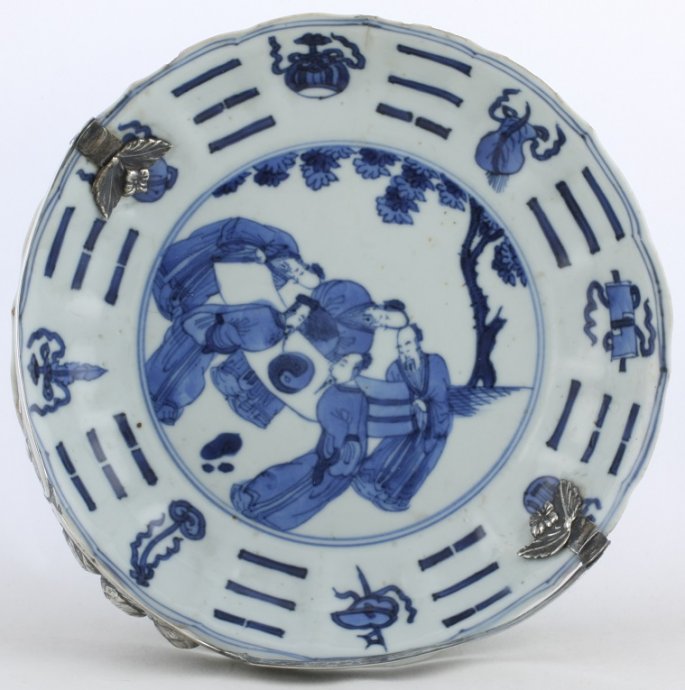
Sold Ceramics - Sold Blue and White Kangxi Period 1660-1722 - Dishes - Page 2
Object 2011715
Dish
China
c.1700
Height 29 mm (1.38 inch), diameter of rim 167 mm (8.27 inch), diameter of footring 103 mm (4.72 inch), weight 185 grams (6.53 ounce (oz.))
Moulded dish on footring with a foliated rim. Fitted with a (marked) Dutch mount. Decorated in underglaze blue with five gentlemen, standing in a landscape, studying an opened scroll under a pine tree. The only subject on this scroll is the symbol of the taiji, the Supreme Ultimate, consisting of the yin and yang. On the sides the Eight Trigrams bagua, alternating with precious symbols On the reverse round the outer footring a continuous foaming waves pattern border. On the base the six-character mark 'Ming Cheng hua nian zhi' (made during the Chenghua reign of the Great Ming Dynasty).
The five gentlemen, standing in a landscape, studying an opened scroll under a pine tree, a symbol of immortality. are depicted as old men with beards; their hair is styled with small chignons. In Chinese tradition they are the Five Ancients, representing the Five Elements of Chinese cosmology, wood, fire, earth, metal and water.
(1) Green Spirit Highest Origin – representing East, Wood and Black
(2) Red Spirit Highest Truth – representing South, Fire and Red
(3) Yellow Spirit Highest Perfectness – representing Middle, Earth and Yellow
(4) Powerful Spirit Highest Purity – representing West, Metal and White
(5) Single Spirit Highest Mystery – representing North, Water, Blue.
(source: S.Fan)
The men gaze at an opened scroll. The only subject on this scroll is the symbol of the jaiji, the Supreme Ultimate, consisting of the yin and yang. (Ströber 2011, pp.20-21)
Yin and yang are the fundamental principles of Chinese philosophy and cosmology. The character yin literally means shady, referring to the northern, shaded side of a valley; yang to the southern, sunny side of a mountain. The imagery of the sides of hills is very striking because there is no boundary between the two. The terms came to denote the positive and negative, male and female principles of universal life and are represented by taiji, the Supreme Ultimate. Taiji is symbolised by a circle, differentiated by a sinuous S-shaped line, on one side which is black, the other white. A small circle of the opposite colour is positioned in the centre of each half.
Yang signifies heaven, sun, light, vigour, male, penetration, and is often symbolised by the dragon. Mountains are yang. Yin stands for earth, moon, darkness, quiescence, female, absorption. Valleys and streams have the yin quality.
Yin and yang are not opposites, but complementary polarities, since their interaction creates the rhythm that animates the cosmos as a harmonious whole. This being the reason for the symbolic dot in the centre of each exact counterpart. (Ströber 2011, p.20)
The principle of yin and yang, which generates everything in the cosmos, is also represented by the Eight Trigrams, bagua. Continuous straight lines, yang, are combined with broken lines, yin. Three unbroken lines represent heaven, qian, three broken lines represent earth, kun. The intermediary stages in the cycle from yin to yang form eight basic trigrams. Each has a special meaning and is associated with a colour, an animal or a natural force.
Among them, qian and kun, heaven and earth, are considered the source of everything in the natural world and human society, evolution and cyclical changes.
Paring these eight trigrams they create sixty-four hexagrams, in Chinese traditional belief the principle of all things, basis for science, medicine and divination. The Chinese classic of divination, Yijing (Book of Changes), dates back to the seventh century BC. It is based on these sixty-four hexagrams made up of yin and yang.
It is said that the legendary emperor Fu Xi of the third millennium BC invented this system, and later the Daoists adapted and developed the idea in their classics.
The Eight Trigrams still play an important role in Chinese everyday life and are indispensable for fortune telling. (Little 2000, pp.138-139), (Ströber 2011, p.20)
For a similarly decorated dish, without trigrams, please see:
Condition: Four chips and three frits, one connected with a hairline, to the rim.
References:
Little 2000, pl.14, pp.138-139
Price: Sold.

Sold Ceramics - Sold Blue and White Kangxi Period 1660-1722 - Dishes - Page 2
Object 2011569
Dish
China
1700-120
Height 40 mm (1.58 inch), diameter of rim 275 mm (10.83 inch), diameter of footring 155 mm (6.10 inch), weight 545 grams (19.22 ounce (oz.))
Moulded dish on footring, the spreading sides modelled with pomegranate-shaped panels in low relief, scalloped rim. Decorated in underglaze blue with two ladies in a garden landscape near a fence with flowering plants, trees, the sun and a taihu rock. On the sides large panels alternately filled with flowering plants and a single flowering stem above the panels insects. Around the rim a trellis pattern border with half flower heads. On the reverse two flower sprays.
The composition and iconography of this specific dish is consistent with the normal export assortment of blue-and-white Kangxi porcelain of c.1700. The centre design, combined with the spreading sides and modelled pomegranate-shaped panels in low relief must have been very popular at the begin of the eighteenth century. Dishes with this shape and design is also known decorated in 'Red & Gold' / 'Rouge-de-fer' with iron-red, black enamel and gold on the glaze. The spreading sides and modelled pomegranate-shaped panels in low relief can also be found on dishes decorated in famille verte enamels. In the cargo of the Ca Mau shipwreck, c.1725 (Amsterdam 2007, p.179) a series of eight dishes were found and auctioned decorated in underglaze blue with identical border designs, for these dishes, please see:
For similarly in 'Red & Gold' / 'Rouge-de-fer' with iron-red, black enamel and gold on the glaze decorated dishes, please see:
- Red & Gold / Rouge-de-fer 1690-173 / Object 2011445
- Sold Seramics / Sold Red & Gold / Rouge-de-fer 1690-173 / Object 2011453.
- Chinese export porcelain. Chine de Commande, (D.F. Lunsingh Scheurleer, London, 1974), English translation of the Dutch edition, Hilversum 1966, cat. 147.
Condition: A few glaze rough spots with a chip and a hairline the rim.
References:
Lunsingh Scheurleer 1974, cat. 318 & 319
Price: Sold.
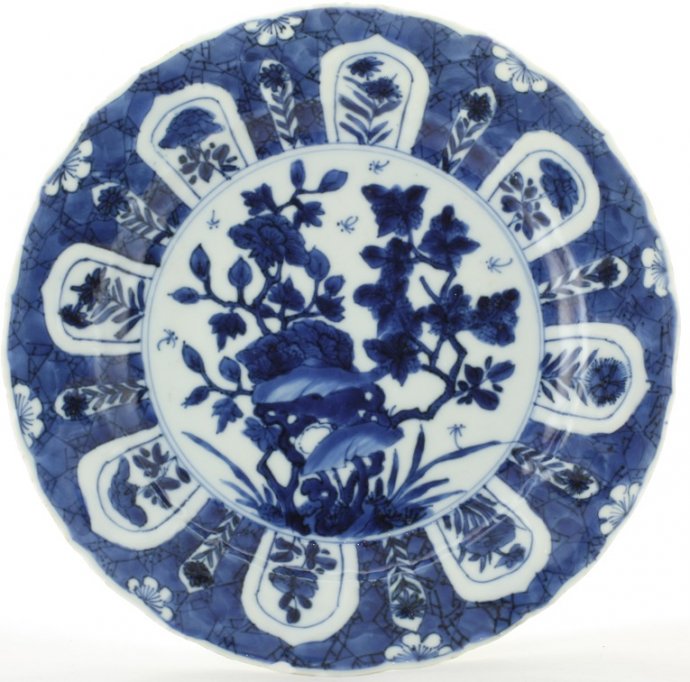
Sold Ceramics - Sold Blue and White Kangxi Period 1660-1722 - Dishes - Page 2
Object 2010476
Dish
China
1700-1720
Height 27 mm (1.65 inch), diameter of rim 215 mm (10.95 inch), diameter of footring 111 mm (5.91 inch), weight 315 grams (11.11 ounce (oz.))
Dish on footring with a moulded form and and a foliated rim. Decorated in underglaze blue with flowering plants growing from a taihu rock and insects in flight. On the sides eight moulded lotus-petal panels with flowering plants alternating with smaller panels with a flowering stem, on the rim eight half flower heads in reserve against a crackled-ice ground. The reverse with eight auspicious symbols, round the foot a petal pattern border. Marked on the base with the symbol mark 'Lotus', symbol of purity and one of the eight Buddhist Emblems, in a double circle, underglaze blue.
The cracked-ice background was one of the new decorating methods in the Kangxi period: leaving certain decorative elements white on a blue background. Nowadays there is a preference for replacing the term 'cracked-ice' by 'erratic paths', after the paths of that name in Chinese gardens, as depicted on paintings and blockprinting from which this motif may derive. (Hartog 1990, p.149)
Jörg shows a Japanese dish 1700-1730 with an identically decorated reverse side probably made as a more or less contemporary copy in an attempt to compete on the market. (Jörg 2003/1, p.139)
For objects decorated with a cracked-ice pattern, please see:
- Pronken met Oosters Porselein, exhibition catalogue Gemeentemuseum Arnhem, (S. Hartog, Zwolle, 1990), p.67, cat. 50 & p.89, cat 93.
- Chinese Ceramics in the Collection of the Rijksmuseum Amsterdam, The Ming and Qing Dynasties, (C.J.A. Jörg in collaboration with J. van Campen, Phlip Wilson in association with The Rijksmuseum Amsterdam, London 1997), p.113, cat. 112 & 213.
Condition: Two frits, two chips and two hairlines to the rim. Some shallow frits and chips to the footring, glaze rough spots to the rim and some scratches to the glaze,
References:
Jörg & Van Campen 1997, cat. 112 & 213
Price: Sold.
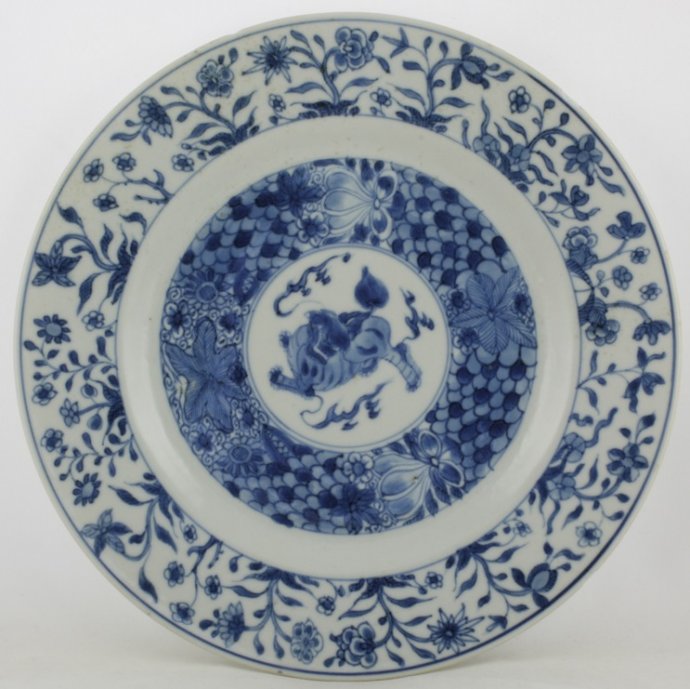
Sold Ceramics - Sold Blue and White Kangxi Period 1660-1722 - Dishes - Page 2
Object 2011896
Dish
China
1710-1720
Height 25 mm (0.98 inch), diameter of rim 247 mm (9.72 inch), diameter of footring 133 mm (5.24 inch), weight 480 grams (16.93 ounce (oz.))
Dish on footring with a wide flat rim. Decorated in underglaze blue with a qilin in a central roundel surrounded by flower heads on an underglaze blue scale pattern ground. The sides are undecorated. On the rim single, repetitive flower stems. The reverse with two flower sprays. Marked on the base with the symbol mark: Lozenge, one of the Eight Precious Symbols. Symbol of victory and success, in a double circle, underglaze blue.
The qilin, like the dragon, the phoenix and the Black Warior tortoise, is one of the Four Divine Creatures, siling. The qilin, like the dragon, is a combination of parts, attributes and characteristics of other animals. It has a sheep's head, dragon's scales of fur, a deer's body, the feet and hooves of a horse and the tail of an ox. It can have one horn or a pair of horns on its head. These horns, unlike those of other horned creatures, are fleshly and tipped with white hair. This peculiarity makes it an animal unfit for aggression or war. The qilin for Western perception a strange and fierce-looking creature, is in Chinese mythology most auspicious. It stands for perfect goodwill, benevolence, gentleness and integrity. It is, like the phoenix, said to be very kind towards other living beings. When among other animals, they would lose all sense of their own mutual fear and would not harm each other. When a qilin appears in the world, it is always a happy omen. It comes to humanity only when great events foreshadow the birth of a sage. For this reason, it is most identified with Confucius. It is said that before his birth one appeared to his mother. (Ströber 2011, p.66)
The presence of the qilin in paintings and decorative arts can be considered a compliment to the reigning emperor. As a result of this symbolic significance, in 1662 the Kangxi Emperor, on the urgings of his advisors, instated the mythical qilin as the highest symbol of rank amongst his military officers,replacing the lion on the military rank badges. There it remained untill the fall of the empire in 1911. (Bjaaland Welch 2008,pp.140-141)
In VOC documents this type is called a 'double dinner plate', which is larger than a normal plate of c.230 mm. It's rather special in that the flat shape clearly reflects the model that was used by the Chinese potter, namely a Dutch pewter plate. This type of plate was produced for only a short period, c.1695-1710; it was succeeded by slightly deeper plates, see sold object 2011612. The decoration on the rim also shows Western influence in the stiff repetition of different flowers, probably based on European printed designs.
For an identically shaped and decorated dish, please see:
For dishes with identically decorated rims, please see:
- "Een verzameling blauw-en-wit Chinees porselein te Brummen", ANTIEK, IV-3, October 1969, p.127, cat. 15.
- European Noble and Private Collections. Including the G.A.H. Buisman Jzn. Chinese Armorial Porcelain Collection, auction catalogue Christie’s Amsterdam, 14-16 February 2006, p.419, lot 1060.
- Chinese Armorial Porcelain for the Dutch Market, Chinese Porcelain with Coats of Arms of Dutch Families, (J. Kroes, Waanders Publishers, Zwolle, 2007), pp.111-112, cat. no. 10 & 11.
- 300 Treasures, (F. Suchomel, Academy of Arts, Architecture and Design in Prague, Prague, 2015), p.237, cat. 116.
Previously sold object 2011472 is a similarly shaped and sized dish but with a different central (floral) design
The design was also used on armorial porcelain for the Dutch market. On this similarly shaped and sized dish the coat of arms of the Potken family from Oldenzaal the Netherlands was used (c.1718-20). (Reproduced from Chinese Armorial Porcelain for the Dutch Market, Chinese Porcelain with Coats of Arms of Dutch Families, (J. Kroes, Waanders Publishers, Zwolle, 2007), pp.111-112, cat. no. 10 & 11.)
Sold object 2011612 (above) with a straight, instead of a flat, rim is also similarly decorated with a different central (floral) design.
Condition: Two frits and three shallow chips to the rim and a chip with some shallow rough spots to the footring.
References:
Lunsingh Scheurleer 1969, cat. 15
Fischell 1987. pp.30-31, cat. C
Jörg & Van Campen 1997, cat. 291
Bjaaland Welch 2008,pp.140-141
Price: Sold.

Sold Ceramics - Sold Blue and White Kangxi Period 1660-1722 - Dishes - Page 2
Object 2011472
Dish
China
c.1700
Height 27 mm (1.06 inch), diameter of rim 244 mm (9.60 inch), diameter of footring 123 mm (4.84 inch)
Dish on footring with a wide flat rim. Decorated in underglaze blue with flower sprays in bands around a medallion with a flower in the centre. On the rim single, repetitive flower stems. The reverse with two flower sprays. Marked on the base with the symbol mark: Lozenge, one of the Eight Precious Symbols. Symbol of victory and success, in a double circle, underglaze blue.
In VOC documents this type is called a 'double dinner plate', which is larger than a normal plate of c.230 mm. It's rather special in that the flat shape clearly reflects the model that was used by the Chinese potter, namely a Dutch pewter plate. This type of plate was produced for only a short period, c.1695-1710; it was succeeded by slightly deeper plates, sold object 2011612. The decoration on the rim also shows Western influence in the stiff repetition of different flowers, probably based on European printed designs.
For dishes with identically decorated rims, please see:
- "Een verzameling blauw-en-wit Chinees porselein te Brummen", ANTIEK, IV-3, October 1969, p.127, cat. 15.
- European Noble and Private Collections. Including the G.A.H. Buisman Jzn. Chinese Armorial Porcelain Collection, auction catalogue Christie’s Amsterdam, 14-16 February 2006, p.419, lot 1060.
For a identically shaped dish, please see;
- Chinese Ceramics in the Collection of the Rijksmuseum, Amsterdam. The Ming and Qing Dynasties, (C.J.A. Jörg in collaboration with J. van Campen, Philip Wilson Publishers Limited, London, 1997), p.255, cat. 291.
Condition: A fleabite and some very shallow glaze rough spots to the rim. Some frits and chips to the footring.
References:
Lunsingh Scheurleer 1969, cat. 15
Jörg & Van Campen 1997, cat. 291
Price: Sold.
More pictures of object 2012536, another identically, shaped, sized and decorated, sold, dish >>

Sold Ceramics - Sold Blue and White Kangxi Period 1660-1722 - Dishes - Page 2
Object 2011612
Dish
China
c.1700-1720
Height 50 mm (1.97 inch), diameter of rim 261 mm (10.28 inch), diameter of footring 159 mm (6.26 inch), weight 586 grams (20.67 ounce (oz.))
Dish on footring with a straight rim. Decorated in underglaze blue with flowering plants in a central roundel surrounded by a scroll of issuing lotus flowers in a double concentric band surrounded by large flower heads on a underglaze blue scale pattern ground. On the rim single, repetitive flower stems. The reverse with two flower sprays. .
This type of plate with the straight rim was the successor of the in VOC documents called 'double dinner plate', see sold object 2011472, which is larger than a normal plate of c.230 mm. this type was rather special in that the flat shape clearly reflects the model that was used by the Chinese potter, namely a Dutch pewter plate. The decoration on the rims of both dishes also shows Western influence in the stiff repetition of different flowers, probably based on European printed designs.
For dishes with identically decorated rims, please see:
- "Een verzameling blauw-en-wit Chinees porselein te Brummen", ANTIEK, IV-3, October 1969, p.127, cat. 15.
- European Noble and Private Collections. Including the G.A.H. Buisman Jzn. Chinese Armorial Porcelain Collection, auction catalogue Christie’s Amsterdam, 14-16 February 2006, p.419, lot 1060.
Condition: A wide hairline to the centre, a frit and two chips top the rim.
References:
Lunsingh Scheurleer 1969, cat. 15
Jörg & Van Campen 1997, cat. 291
Price: Sold.
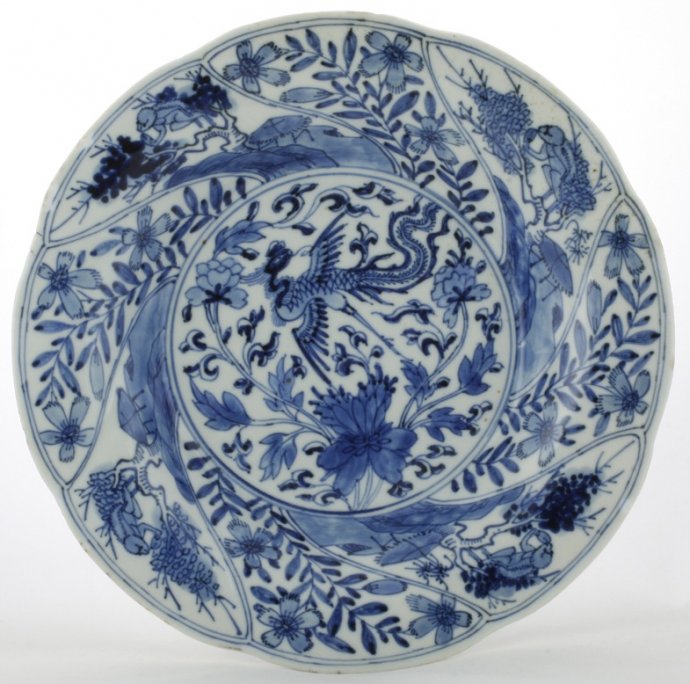
Sold Ceramics - Sold Blue and White Kangxi Period 1660-1722 - Dishes - Page 2
Object 2011063
Dish
China
1700-1720
Height 34 mm (1.34 inch), diameter of rim 213 mm (8.38 inch), diameter of footring 99 mm (3.90 inch)
Moulded dish on footring with a curving spirally rim fluted in eight lobes. Decorated in underglaze blue with a feng-huang or phoenix and a peony spray in the centre, and in the radiating panels with a monkey in a peach tree alternating with a spray of carnations: on the reverse are eight flower sprays. Marked on the base with the symbol mark: Flower, the symbol for purity in a double circle, underglaze blue.
This dish is a fine and characteristic example of the Kangxi cobalt-blue and style of painting The dish imitates a common European silver form, which may however have been transmitted by way of an intermediary in delftware. (Howard & Ayers 1981, p.35)
For a similarly decorated dish, please see:
Condition: A firing flaw to the rim and footring and various chips, frits and fleabites to the glaze of the rim.
References:
Lunsingh Scheurleer 1966, cat. 18
Howard & Ayers 1978, vol. 1, p.64
Lunsing Scheurleer 1989, cat. 72
Price: Sold.
More pictures of object 2010877, another identically, shaped, sized and decorated, sold dish >>

Sold Ceramics - Sold Blue and White Kangxi Period 1660-1722 - Dishes - Page 2
Object 2011435
Dish
China
1710-1735
Height 34 mm (1.34 inch), diameter 232 mm (9.13 inch), diameter of footring 126 mm (4.96 inch)
Dish on footring with a convex centre and a flat rim. The rim in underglaze brown (jia mangkou). (Sargent 2012, p.183). Decorated in underglaze blue on the convex centre with a court in session in a double concentric band. On the sides four groups of flowering plants; prunus, peony, lotus and chrysanthemum. Around the rim a continuous decoration of a lady in an interior, two figures in a garden with trees and a fence and one figure on a balustrade On the reverse rim eight peony flower heads and on the sides four groups of flowering plants; prunus, peony, lotus and chrysanthemum.
In the collection of the Rijksmuseum Amsterdam are three Chinese Imari decorated dishes with rising convex bases. This type of dish, called a "butter dish" in the Netherlands, is also found in Delft earthenware. Besides a large knob of butter, this specific shape with its raised middle section could also be used for milk-puddings, savarin cakes and similar baked products served with butter or syrup sauces.
For identically decorated dishes, please see:
- Chinese Porcelain, (W.G. Gulland, vol. 1, London 1911), pl. 245.
- Het Chinese porselein in de collectie Frits Lugt / The Frits Lugt collection of Chinese porcelains, (D.F. Lunsingh Scheurleer in Mededelingenblad Nederlandse Vereniging van Vrienden van de Ceramiek, vols. 103/104, Lochem 1981), p.77, cat. 86.
- 300 Treasures, (F. Suchomel, Academy of Arts, Architecture and Design in Prague, Prague, 2015), p.205, cat. 86.
Condition: Two glaze firing flaws to the convex centre, three shallow glaze frits to the rim and some frits to the footring.
References:
Lunsingh Scheurleer 1977, cat. 176
Lunsingh Scheurleer 1981, cat. 86
Price: Sold.

Sold Ceramics - Sold Blue and White Kangxi Period 1660-1722 - Dishes - Page 2
Object 2011158
Dish
China
c.1700
Height 27 mm (1.06 inch), diameter of rim 185 mm (7.28 inch), diameter of footring 97 mm (3.82 inch)
Moulded dish on footring, the curving spirally cavetto and rim fluted in both eight lobes. Decorated in underglaze blue with flowering chrysanthemum and peony plants growing from rockwork. The radiating moulded panels in the cavetto are filled with fish swimming in waterweeds such as pondweed, duckweed and lotus alternating with water plants. The radiating panels on the rim are decorated with flowering branches. On the reverse three sprays of flowering branches. Marked on the base with the symbol mark: Flower, the symbol for purity in a double circle, underglaze blue.
The four fish might be identified as a "qing", a fresh water mullet, and "bai", a variety of carp. Carp are identified by the wide mouth and two pairs of barbels attached to their lips. The third one is a "lian", a kind of bream, and a "gui", the mandarin fish, a colourful breed of perch with a large mouth. In Chinese tradition the combination of these fish among lotus and other waterweeds stands for a character phrase, qingbai lijie, meaning unsullied and incorruptible, a reference to the Confucian ideal of the perfect gentlemen. (Ströber 2011, pp.104-106)
Condition: A fleabite, two frits and two shallow glaze chips to the rim.
References:
Price: Sold.

Sold Ceramics - Sold Blue and White Kangxi Period 1660-1722 - Dishes - Page 2
Object 2011428
Dish
China
c.1700
Height 34 mm (1.34 inch), diameter of rim 210 mm (8.27 inch), diameter of footring 115 mm (4.53 inch)
Moulded dish on footring wiith panelled sides and a lobbed rim. Decorated in underglaze blue with a round shaped medallion an attractively painted decoration of a flowering peony and chrysanthemum plant growing from a taihu rock with a bee, a butterfly and various other insects in flight. The sides and rim are divided into twenty three moulded panels each divided with a large panel filled with flowering plants and a small panel filled with a bird in flight. On the exterior rim four sprays of flowering plants. Marked on the base with the single character mark: Yu, (Jade (Yuan to Qing)), in a double circle, underglaze blue
The Yu, "jade", character mark is traditionally called the F-mark in the Netherlands and is very common on good-quality blue and white Kangxi export porcelain. (Jörg & Van Campen 1997, p.115)
Condition: A "V"-shaped hairline, a hairline, two frits and two chips to the rim.
References:
Jörg & Van Campen 1997, cat. 116
Price: Sold.


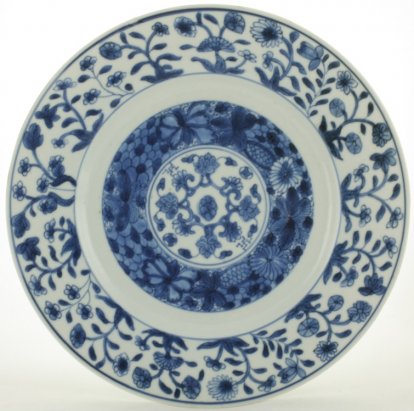
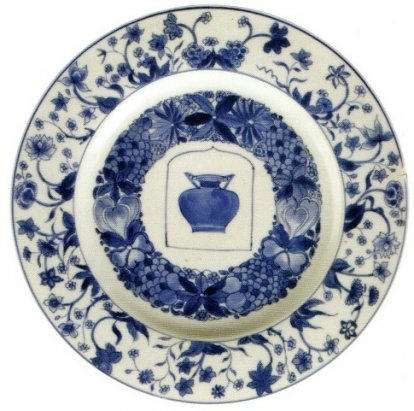
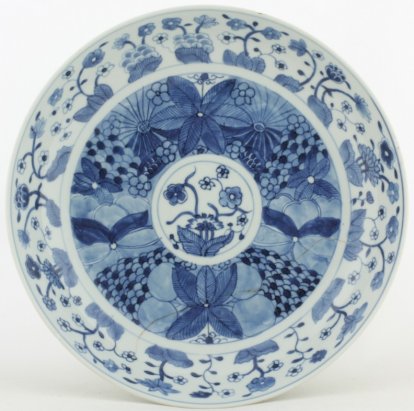
 create websites
create websites